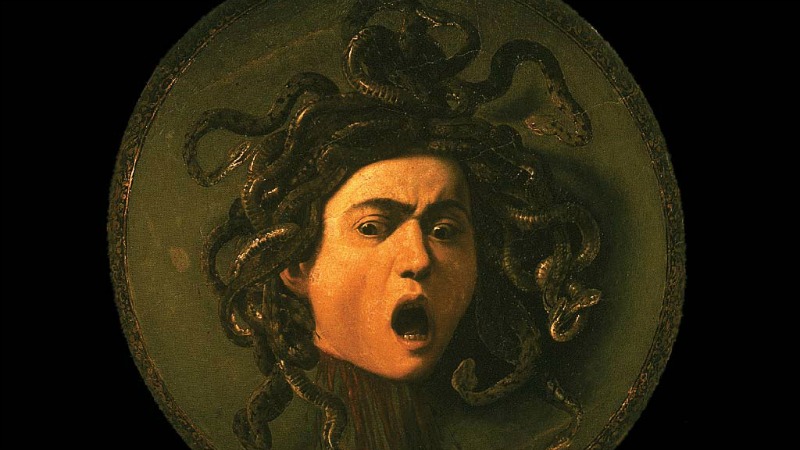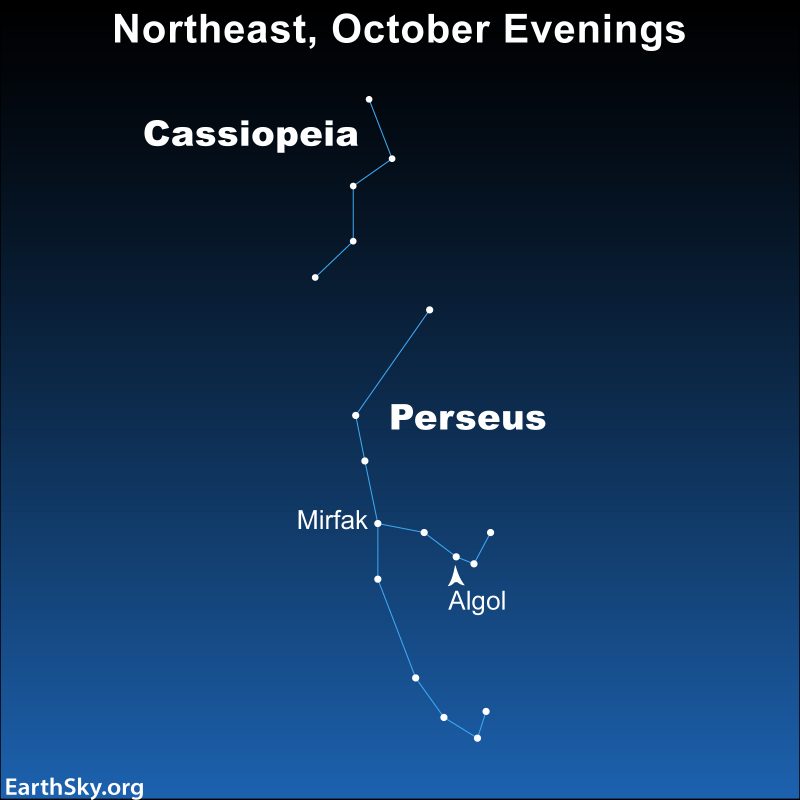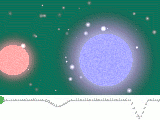
Algol is the Demon Star?
What’s the scariest star in the sky? If you were one of the early stargazers, you might have chosen Algol in the constellation Perseus. Early astronomers nicknamed it Algol the Demon Star for its strange behavior. Shivers!
When you look at Algol, it doesn’t appear any scarier than any other star, at least not at first. But, in skylore, the star is associated with a mythical scary monster – the Gorgon Medusa – who had snakes for hair. Legend said that her appearance was so terrifying that if anyone even looked at her, they would turn to stone.
The star Algol takes its name from an Arabic word meaning the Demon’s Head or, literally the Ghoul. It represents the terrifying snaky head of the Medusa monster.
But why? Why did the early stargazers associate the star Algol with the Goron Medusa? It seems the ancients might have associated this star’s variable brightness with the evil, winking eye of the Medusa.

What’s so scary about it?
In skylore, Perseus was a great hero often depicted mounted on Pegasus the Flying Horse. In the mythology of the skies, Perseus slew Medusa. Then, he used Medusa’s head to his advantage, showing it to Cetus the Sea-monster to turn him into stone.
All of these constellations are in the sky at this time of year.
And Algol is a known variable star, which waxes and wanes in brightness.
The early stargazers surely knew about its changing brightness. This probably led them to name the strangely behaving star in the sky for a mythological demon.
Algol is a variable star
There are many variable stars known throughout the heavens. But Algol might be the most famous of them. That’s because the Demon Star brightens and dims with clockwork regularity. It completes one cycle in 2 days, 20 hours and 49 minutes.
Plus, you can view its entire cycle with your eye alone.
At its brightest, Algol shines about three times more brightly than at its faintest. When it reaches maximum brilliance, Algol matches the brightness of the nearby second-magnitude star Almach. At minimum, Algol’s light output fades to that of the star Epsilon Persei.
Modern-day astronomy has unlocked the secret of Algol’s mood swings. It’s an eclipsing binary star. This kind of binary star is composed of two stars, with each star revolving around the other. From Earth, we see the orbital plane of this binary star almost exactly edge-on. Therefore, when the dimmer of the two stars swings in front of the brighter star, we see Algol at minimum brightness.

How to find Algol the Demon Star
Luckily, the Demon Star is easy to find. Our sky chart shows the northeastern sky for autumn evenings, especially around Halloween.
First, look for the conspicuous W or M-shaped constellation Cassiopeia. It’ll enable you to star-hop to Perseus. Then, look below Cassiopeia toward the horizon to spot the dangling icicle shape of Perseus. Off to the right of the icicle is Algol. At mid-northern latitudes, the Demon Star appears for at least part of the night all year round. But it’s best seen in the evening sky from autumn to spring. It’s visible in the northeast sky in autumn, shines high overhead in winter, then swings to the northwest sky by spring.

Bottom line: Algol has the nickname the Demon Star because it represents the head of Medusa. This variable star probably intrigued the ancients with its fluctuating behavior.
The post Algol the Demon Star … but why is it called that? first appeared on EarthSky.
from EarthSky https://ift.tt/vuJEtFY

Algol is the Demon Star?
What’s the scariest star in the sky? If you were one of the early stargazers, you might have chosen Algol in the constellation Perseus. Early astronomers nicknamed it Algol the Demon Star for its strange behavior. Shivers!
When you look at Algol, it doesn’t appear any scarier than any other star, at least not at first. But, in skylore, the star is associated with a mythical scary monster – the Gorgon Medusa – who had snakes for hair. Legend said that her appearance was so terrifying that if anyone even looked at her, they would turn to stone.
The star Algol takes its name from an Arabic word meaning the Demon’s Head or, literally the Ghoul. It represents the terrifying snaky head of the Medusa monster.
But why? Why did the early stargazers associate the star Algol with the Goron Medusa? It seems the ancients might have associated this star’s variable brightness with the evil, winking eye of the Medusa.

What’s so scary about it?
In skylore, Perseus was a great hero often depicted mounted on Pegasus the Flying Horse. In the mythology of the skies, Perseus slew Medusa. Then, he used Medusa’s head to his advantage, showing it to Cetus the Sea-monster to turn him into stone.
All of these constellations are in the sky at this time of year.
And Algol is a known variable star, which waxes and wanes in brightness.
The early stargazers surely knew about its changing brightness. This probably led them to name the strangely behaving star in the sky for a mythological demon.
Algol is a variable star
There are many variable stars known throughout the heavens. But Algol might be the most famous of them. That’s because the Demon Star brightens and dims with clockwork regularity. It completes one cycle in 2 days, 20 hours and 49 minutes.
Plus, you can view its entire cycle with your eye alone.
At its brightest, Algol shines about three times more brightly than at its faintest. When it reaches maximum brilliance, Algol matches the brightness of the nearby second-magnitude star Almach. At minimum, Algol’s light output fades to that of the star Epsilon Persei.
Modern-day astronomy has unlocked the secret of Algol’s mood swings. It’s an eclipsing binary star. This kind of binary star is composed of two stars, with each star revolving around the other. From Earth, we see the orbital plane of this binary star almost exactly edge-on. Therefore, when the dimmer of the two stars swings in front of the brighter star, we see Algol at minimum brightness.

How to find Algol the Demon Star
Luckily, the Demon Star is easy to find. Our sky chart shows the northeastern sky for autumn evenings, especially around Halloween.
First, look for the conspicuous W or M-shaped constellation Cassiopeia. It’ll enable you to star-hop to Perseus. Then, look below Cassiopeia toward the horizon to spot the dangling icicle shape of Perseus. Off to the right of the icicle is Algol. At mid-northern latitudes, the Demon Star appears for at least part of the night all year round. But it’s best seen in the evening sky from autumn to spring. It’s visible in the northeast sky in autumn, shines high overhead in winter, then swings to the northwest sky by spring.

Bottom line: Algol has the nickname the Demon Star because it represents the head of Medusa. This variable star probably intrigued the ancients with its fluctuating behavior.
The post Algol the Demon Star … but why is it called that? first appeared on EarthSky.
from EarthSky https://ift.tt/vuJEtFY

Aucun commentaire:
Enregistrer un commentaire